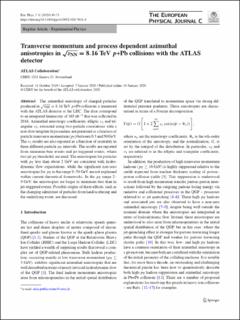Transverse momentum and process dependent azimuthal anisotropies in √sNN−−−=8.16 TeV p+Pb collisions with the ATLAS detector
Aad, Georges; Abbott, Brad; Abbott, Dale C.; Abed Abud, Adam; Abeling, Kira; Abhayasinghe, Deshan Kavishka; Abidi, Syed Haider; AbouZeid, Hass; Abraham, Nadine L.; Abramowicz, Halina; Bjørke, Kristian; Bugge, Magnar Kopangen; Cameron, David Gordon; Catmore, James Richard; Garonne, Vincent; Gramstad, Eirik; Hellesund, Simen; Morisbak, Vanja; Oppen, Henrik; Ould-Saada, Farid; Pedersen, Maiken; Read, Alexander Lincoln; Rye, Eli Bæverfjord; Røhne, Ole Myren; Sandaker, Heidi; Vadla, Knut Oddvar Høie; Buanes, Trygve; Djuvsland, Julia Isabell; Eigen, Gerald; Fomin, Nikolai; Lee, Graham Richard; Lipniacka, Anna; Martin dit Latour, Bertrand; Stugu, Bjarne; Træet, Are Sivertsen; Abreu, Henso; Abulaiti, Yiming; Acharya, Bobby S.; Achkar, Baida; Adachi, Shunsuke; Adam, Lennart; Adam-Bourdarios, Claire; Adamczyk, Leszek; Adamek, Lukas; Adelman, Jareed; Adersberger, Michael; Adigüzel, Aytül; Adorni, Sofia; Adye, Tim; Affolder, Anthony Allen; ATLAS, Collaboration
Journal article, Peer reviewed
Published version

Åpne
Permanent lenke
https://hdl.handle.net/11250/2754998Utgivelsesdato
2020Metadata
Vis full innførselSamlinger
Sammendrag
The azimuthal anisotropy of charged particles produced in sNN−−−√=8.16sNN=8.16 TeV p+Pb collisions is measured with the ATLAS detector at the LHC. The data correspond to an integrated luminosity of 165 nb−1nb−1 that was collected in 2016. Azimuthal anisotropy coefficients, elliptic v2v2 and triangular v3v3, extracted using two-particle correlations with a non-flow template fit procedure, are presented as a function of particle transverse momentum (pTpT) between 0.5 and 50 GeV. The v2v2 results are also reported as a function of centrality in three different particle pTpT intervals. The results are reported from minimum-bias events and jet-triggered events, where two jet pTpT thresholds are used. The anisotropies for particles with pTpT less than about 2 GeV are consistent with hydrodynamic flow expectations, while the significant non-zero anisotropies for pTpT in the range 9–50 GeV are not explained within current theoretical frameworks. In the pTpT range 2–9 GeV, the anisotropies are larger in minimum-bias than in jet-triggered events. Possible origins of these effects, such as the changing admixture of particles from hard scattering and the underlying event, are discussed.
